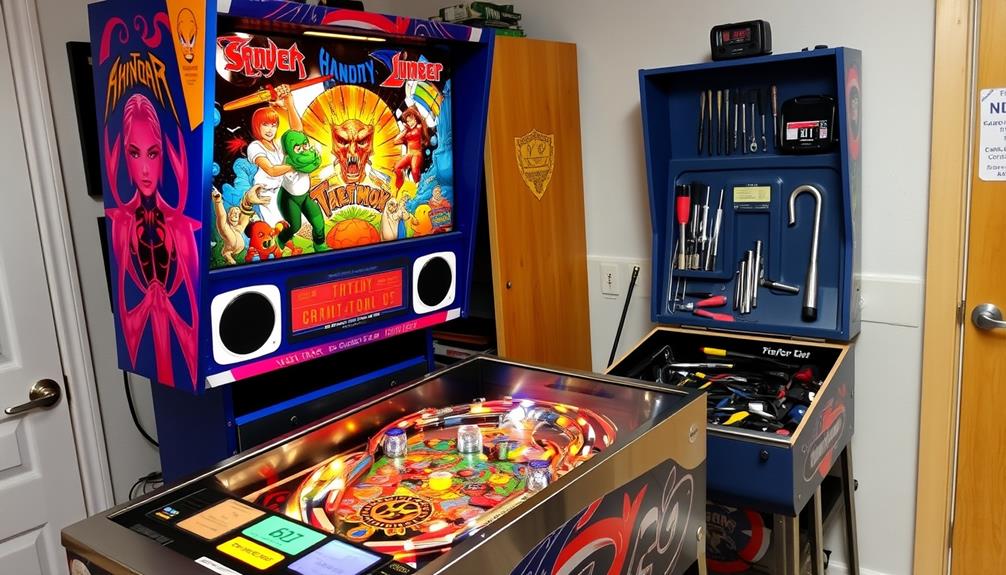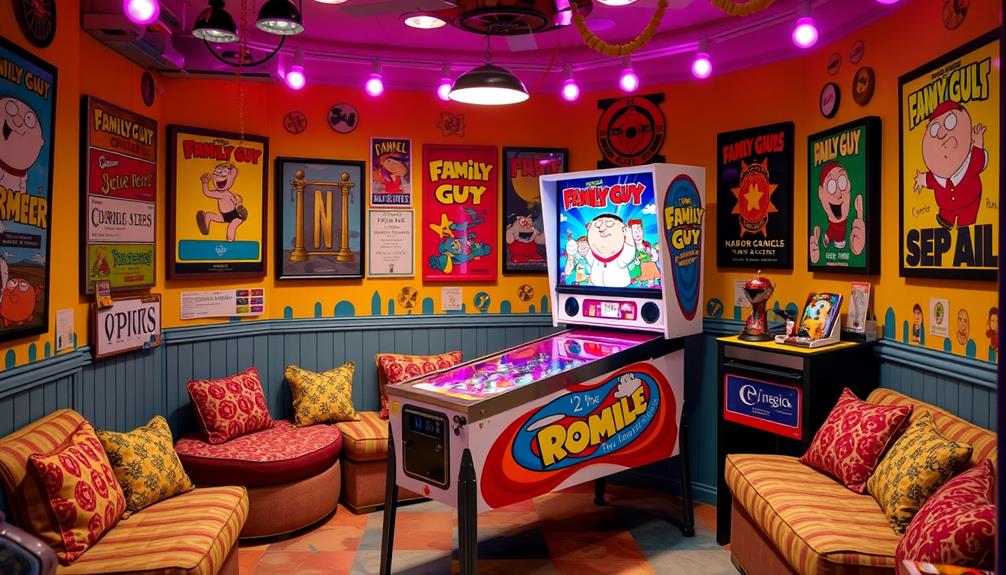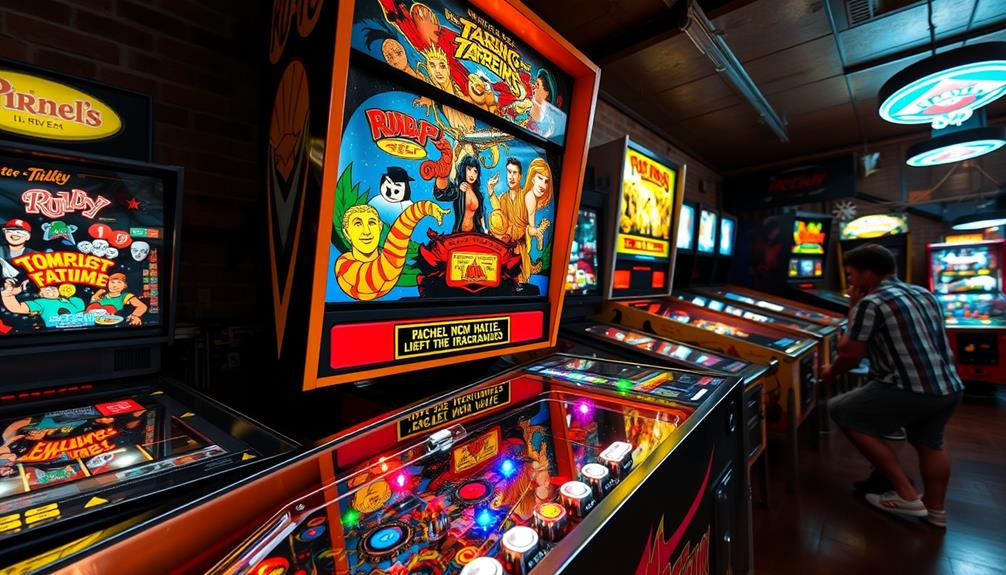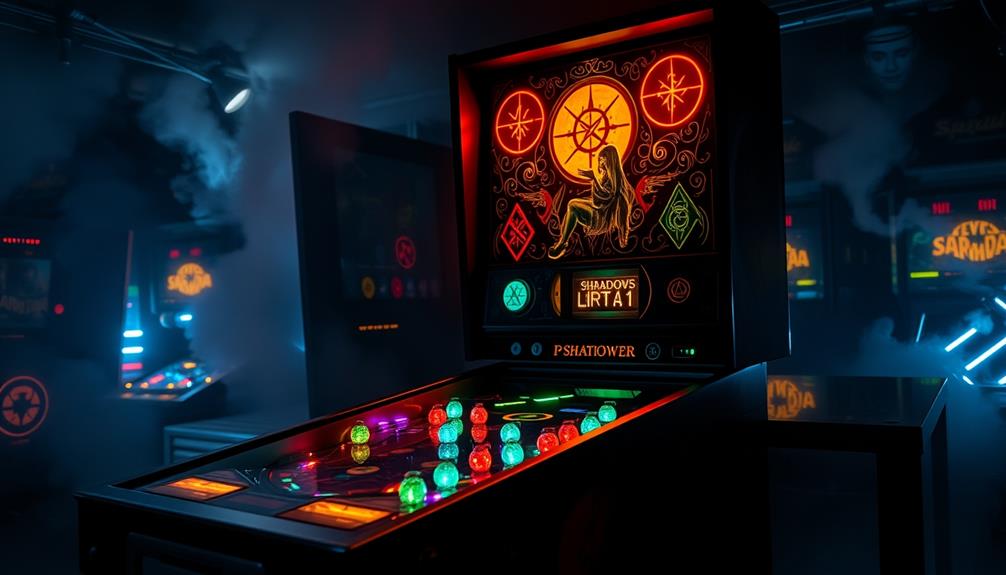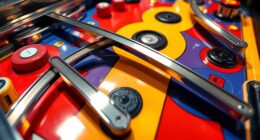Before you buy a pinball machine, keep in mind that most models weigh between 250 and 350 lbs. Heavier machines, like those made by Jersey Jack, can reach up to 500 lbs. This weight impacts how you'll transport, set up, and maintain your machine. Make sure you consider the space you have available and whether your flooring can support the weight. If you're not prepared to move a heavy machine, it could lead to complications later on. There's a lot more to learn about choosing the right pinball machine for your setup!
Key Takeaways
- Standard pinball machines weigh around 250 lbs, while older models can exceed 300 lbs due to solid construction materials.
- Heavier machines, like Jersey Jack Pinball's Hobbit, can weigh up to 400 lbs, affecting transport and setup.
- Ensure your flooring can support the weight, typically ranging from 250 to 350 lbs, to prevent damage.
- Measure your intended space, as standard machines are about 75 inches tall and need room for comfortable play.
- Transporting machines over 300 lbs requires at least two people, proper tools, and planning to avoid injury.
Importance of Pinball Machine Weight
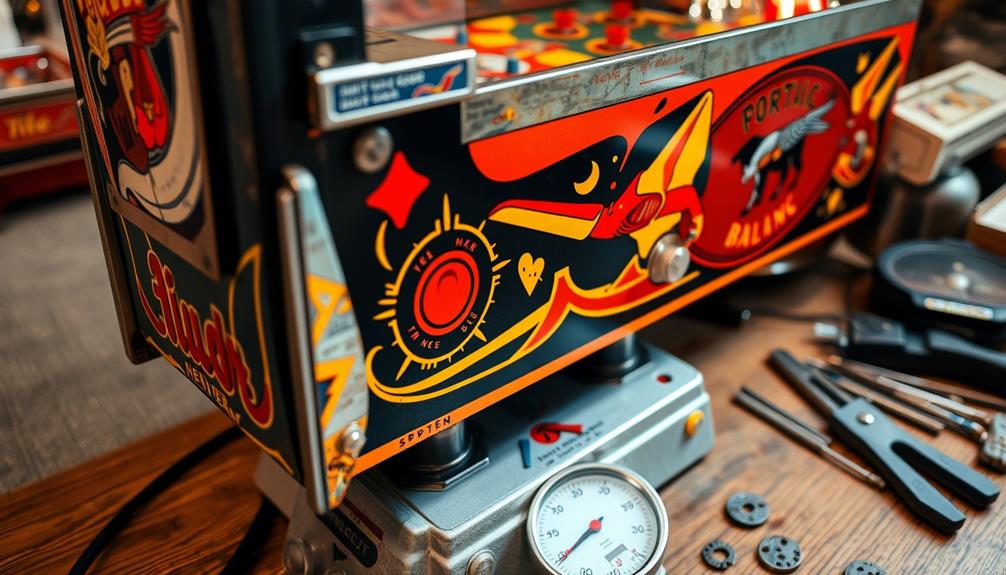
When you think about the experience of owning a pinball machine, the weight plays an important role in your decision-making process. It's not just a number; it affects how you'll transport, place, and enjoy your machine.
Standard pinball machines usually weigh around 250 lbs, but if you're eyeing a wider model from the 90s, you might be dealing with weights up to 350 lbs. This added heft means you'll likely need help moving it, especially for iconic machines like Twilight Zone and Star Trek: The Next Generation, which can weigh between 325 lbs and 350 lbs.
Heavier machines, such as the Jersey Jack Pinball Hobbit, can tip the scales at approximately 400 lbs, making them a real challenge to set up. You must verify you have adequate space for these machines, as their weight can limit placement options in your game room.
Additionally, older pinball machines tend to be heavier due to solid construction, so understanding the weight variations among different manufacturers is significant.
Ultimately, considering the weight of your pinball machine helps you plan for safe transport and proper setup, making sure you can enjoy the game without any unnecessary stress.
Average Weight of Pinball Machines
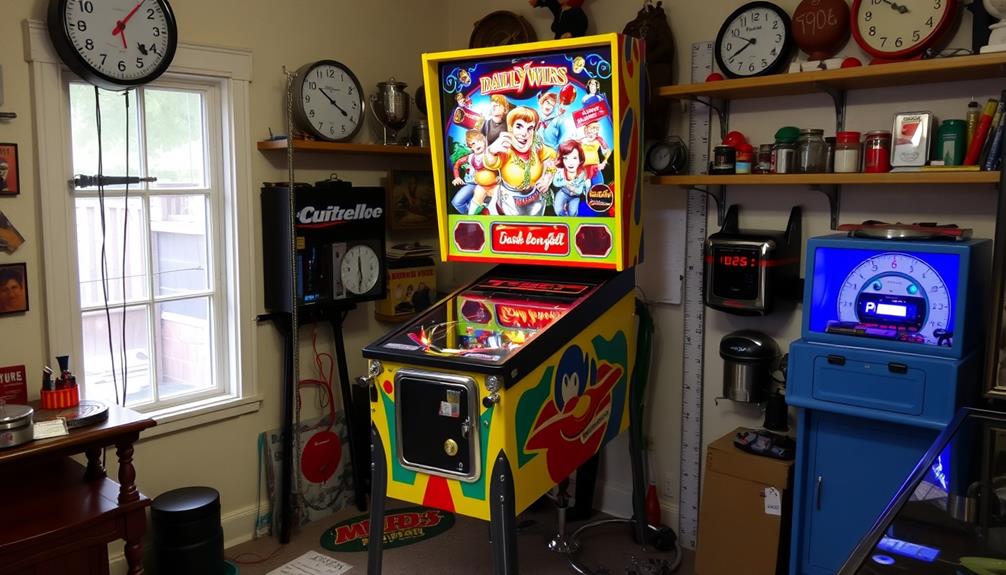
When you're looking at pinball machines, you'll find that the average weight is around 250 lbs, but this can change based on the model and manufacturer.
For instance, widebody machines from the '90s often tip the scales at about 300 lbs, while modern machines like those from Jersey Jack can weigh even more.
Understanding the weight differences among machine types is essential for transport and setup.
Typical Machine Weight Range
The average weight of pinball machines varies considerably, typically ranging from 250 to 350 pounds. If you're buying a pinball machine, it's important to take this weight range into account, as it affects transportation and placement.
Standard machines generally weigh between 250 to 300 pounds, with newer models often being lighter than their older counterparts. For example, modern machines utilizing Spike Systems from manufacturers like Stern average around 250 pounds, making them easier to handle.
On the other hand, widebody games from the 1990s, such as Twilight Zone and Star Trek, typically weigh around 300 to 350 pounds, which can give you a workout when moving them.
If you're looking at Jersey Jack Pinball machines like The Hobbit, expect even more weight—around 310 to 350 pounds—making them some of the heftier choices.
Don't forget about older electro-mechanical (EM) machines. These four-player models can exceed 300 pounds due to their solid construction.
Weight by Machine Type
Understanding the weight of different types of pinball machines can help you make an informed decision when purchasing one. The weight varies considerably based on the machine's design and era.
Here's a quick breakdown of average weights by machine type:
- Standard Machines: Most pinball machines from the 1980s to present typically weigh around 250 lbs. These machines generally have a standard width, making them easier to fit in various spaces.
- Widebody Games: Models from the 1990s, like Twilight Zone and Star Trek, usually tip the scales at around 300 lbs. The added width allows for more intricate playfield designs but also increases weight.
- Pinball 2000 Games: Heavier than their predecessors, games like The Hobbit average about 350 lbs due to their unique construction.
Also, keep in mind that Jersey Jack Pinball machines, such as Wizard of Oz, weigh around 310 lbs but use lighter materials to improve maneuverability.
Knowing these weight differences can help you choose the right machine that fits your space and needs!
Weight Variations by Model
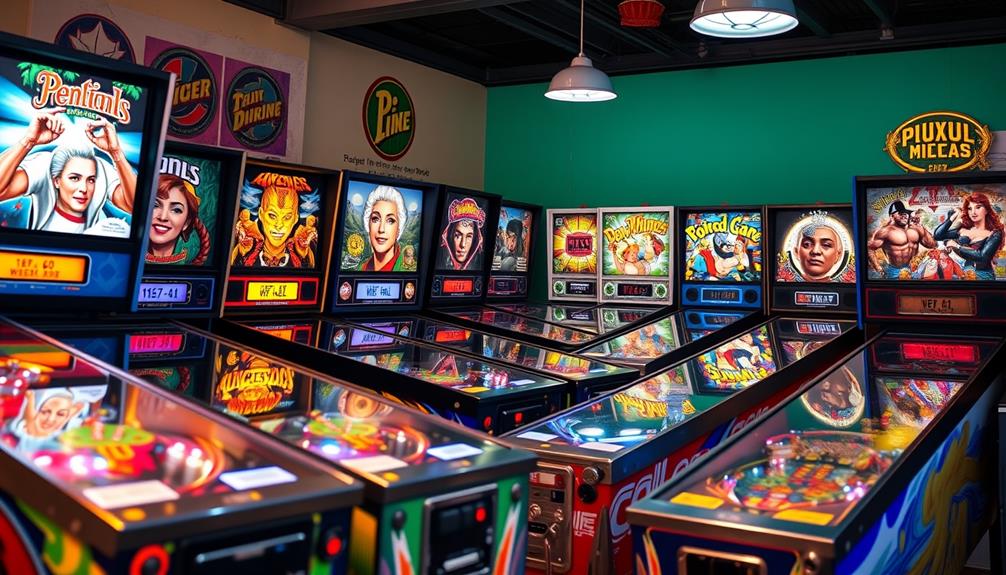
When you're looking at pinball machines, you'll notice significant weight variations by model.
Standard machines typically weigh around 250 lbs, but some heavier models can reach up to 443 lbs, especially those from older series.
In contrast, newer models from manufacturers like Stern often use lighter materials, making them easier to handle but less substantial.
Standard Machine Weight Ranges
Standard pinball machines generally weigh around 250 lbs, but this number can vary considerably depending on the model. When you're considering a new pinball machine, it's important to be aware of these weight variations, as they can greatly influence transportation and setup.
Here's a quick breakdown of some standard weight ranges:
- Standard Machines: Approximately 250 lbs.
- Widebody Games (1990s): Around 300 lbs.
- Pinball 2000 Models: Between 350 lbs and 400 lbs.
Older electro-mechanical (EM) machines can also exceed 300 lbs, particularly four-player models due to their sturdy construction.
For example, notable machines like the Williams WPC series, including Twilight Zone and Star Trek: The Next Generation, weigh around 325 lbs and 350 lbs respectively.
If you're eyeing heavyweight contenders, be prepared for machines like Jersey Jack Pinball's offerings, which can tip the scales at up to 500 lbs.
Knowing these weight ranges will help you make an informed decision when buying your new pinball machine, ensuring you're ready for the logistics involved.
Heavier Models Overview
Heavyweight pinball machines can really pack a punch, both in gameplay and in logistics. If you're eyeing some of the heavier models on the market, you'll notice considerable weight variations.
For instance, standard pinball machines typically weigh around 250 lbs, but widebody games from the 90s, like Twilight Zone and Star Trek, can tip the scales at 325 to 350 lbs.
Jersey Jack Pinball has made a name for itself with its heavy offerings. The Wizard of Oz weighs approximately 310 lbs, while The Hobbit is speculated to weigh around 350 lbs, making them heftier than many other models.
Older electro-mechanical machines, especially the four-player models from manufacturers like Bally and Gottlieb, can also exceed 300 lbs thanks to their solid construction materials.
Additionally, Pinball 2000 games, known for their unique design, weigh around 350 lbs, presenting transport challenges similar to those found with Jersey Jack machines.
As you can see, the weight of pinball machines varies greatly, so it's essential to evaluate these factors before making your purchase.
Light Models Comparison
While many pinball enthusiasts appreciate the heft of traditional machines, lighter models offer a revitalizing alternative that simplifies transport and setup.
These light models are perfect for those who want to enjoy the game without the hassle of moving heavy equipment. Here are a few notable options:
- Fireball Home Edition: Known for its compact design, this model emphasizes portability and ease of use.
- Stern Spike Systems: Weighing around 250 lbs, these machines present a manageable option compared to older models.
- Jersey Jack Pinball (JJP): Although these machines are known for quality, they can weigh around 350 lbs, making them less ideal for frequent relocation.
When you're considering a brand new pinball machine, it's essential to think about weight variations.
Newer machines are designed with lighter materials, resulting in a noticeable reduction in weight compared to vintage models from manufacturers like Bally and Gottlieb.
Transporting Heavy Machines
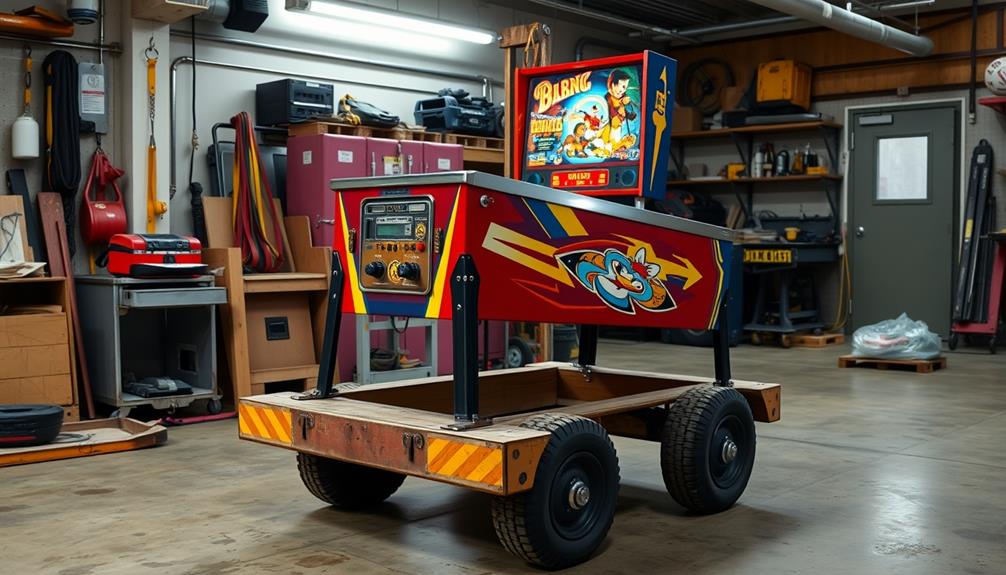
Transporting a pinball machine can be an intimidating task, especially when dealing with models that weigh over 300 pounds. When you're transporting heavy machines like these, it's essential to have at least two people on hand. This guarantees safe transport and better maneuverability.
Using a dolly, particularly a stair climbing dolly like the Powermate Hand Truck, can make the process a lot easier, especially when you need to navigate stairs.
One effective technique is to carry both ends of the machine without the legs, but it's generally recommended to use a dolly for improved stability and ease of transport.
If you're dealing with an older model, consider removing the head; this can greatly reduce the weight and make moving it much simpler.
Moving Techniques for Safety

When it comes to moving pinball machines, safety should always be your top priority. These machines can be quite heavy, averaging around 250 lbs, so using the right moving techniques is essential to prevent injury and guarantee a smooth transport.
Many enthusiasts also recommend considering optimal angles for gameplay when positioning your machine post-move. Here are three important tips to keep in mind:
- Use a Dolly: Opt for a stair climbing dolly, like the Powermate Hand Truck, for easier maneuverability, especially when maneuvering stairs.
- Remove the Head: If you're dealing with an older model, removing the head can greatly reduce weight, making it easier to transport through tight spaces.
- Employ Furniture Movers: Slide machines with legs using furniture movers to help distribute weight evenly, making handling more manageable.
Always remember to lift properly by carrying both ends without the legs, and make sure you have a buddy to assist you.
With these techniques, you can safely move your pinball machine without the risk of injury or damage. Prioritize safety, and your transport experience will be much smoother!
Space Requirements for Machines

After guaranteeing a safe move, it's time to ponder the space requirements for your pinball machine.
Standard machines typically measure about 75 inches in height, 29 inches in width, and 55 inches in depth. You'll need ample space for setup, guaranteeing players can stand comfortably and maneuver their hands while enjoying the game.
Given that pinball machines often weigh between 200 and 300 pounds, it's vital to evaluate the available space for potential relocation or movement. Most modern machines fit through standard doorways, but if you're dealing with tighter spaces, you might need to disassemble the machine by removing the head.
Before you go ahead and purchase a pinball machine, take the time to measure the intended location. Confirm that it can accommodate both the dimensions and weight of the machine you're evaluating.
This will save you from any last-minute surprises and guarantee that your new pinball machine has a dedicated and enjoyable space to call home.
Planning your space requirements ahead of time will lead to a smoother setup and a better gaming experience.
Impact of Weight on Flooring
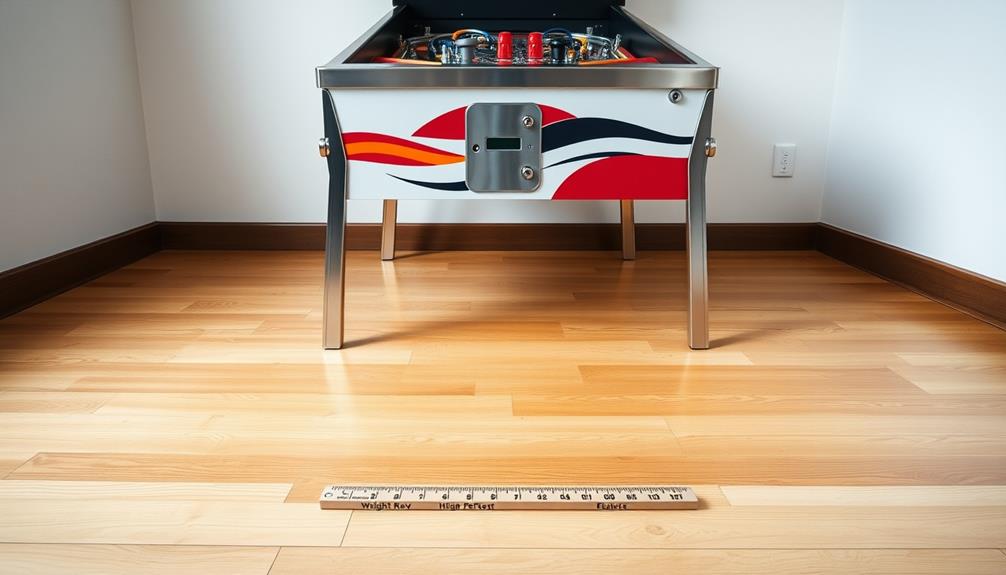
Pinball machines are heavy, and their weight can considerably impact your flooring. Weighing between 250 to 350 pounds, or even more, these machines require careful consideration to avoid damaging your floors. Here's what you need to know:
- Floor Strength: Confirm your flooring can support the weight. Weaker surfaces, like carpet, may not handle the stress well.
- Footprint Consideration: A standard pinball machine occupies about 29 inches wide and 55 inches deep. Make sure you distribute its weight evenly across a sturdy surface.
- Surface Recommendations: Place your pinball machine on strong flooring, such as hardwood or reinforced concrete, to prevent sagging or cracking over time.
If you're concerned about floor stability, consider using a platform or mat designed for heavy equipment. This can help protect your flooring from the machine's considerable weight.
Maintenance Considerations and Weight
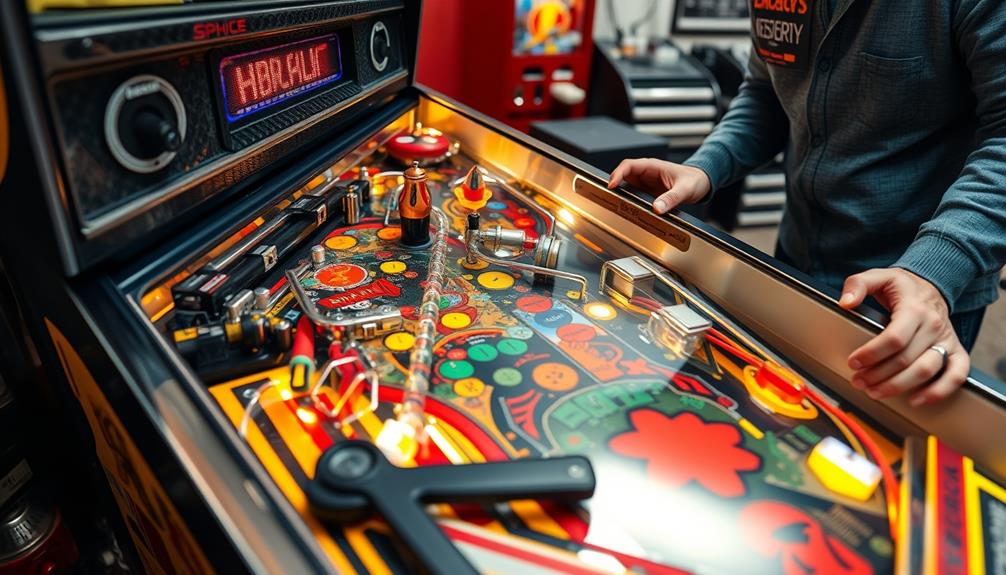
Maintaining a pinball machine can be a challenging task, especially considering their hefty weight. Most machines weigh between 250 to 350 lbs, making them cumbersome to move for repairs or adjustments. If you own a heavier model, like the Jersey Jack Pinball Hobbit at around 350 lbs, you'll need to plan carefully and possibly enlist help for transport and maintenance.
Regular maintenance is essential for keeping your machine in top shape. This often involves cleaning, replacing parts, and conducting thorough inspections.
However, the weight of older, four-player electro-mechanical machines, which can exceed 300 lbs, adds complexity to these tasks. You'll find that accessing critical components requires more effort than with modern, lighter machines.
Understanding your pinball machine's weight can help you anticipate the maintenance challenges ahead. Before diving into any repairs, consider the logistics involved in moving the machine.
Having the right tools and assistance can make your maintenance experience smoother. Ultimately, being mindful of your machine's weight will help you keep it running well for years to come.
Frequently Asked Questions
How Much Does an Average Pinball Machine Weigh?
An average pinball machine weighs around 250 pounds. However, some models can be heavier, reaching up to 350 pounds. So, if you're considering a purchase, keep the weight in mind for transportation.
What Is the Best Selling Pinball Machine of All Time Required?
Did you know the Williams "Addams Family" pinball machine sold over 20,000 units? It's the best-selling pinball machine ever, celebrated for its engaging gameplay and nostalgic themes that captivate both collectors and casual players alike.
What Is Considered a Good Score in Pinball?
A good score in pinball usually means hitting over 1 million points. Mastering the game's rules and reaching wizard mode can boost your score considerably. Aim high, and you'll enjoy the thrill of competition!
Are Pinball Machines Going up in Value?
Yes, pinball machines are going up in value. Vintage and limited edition models, especially, are highly sought after. As more collectors enter the market, you'll likely see prices continue to appreciate over time.
Conclusion
In summary, understanding the weight of a pinball machine is essential before making your purchase. Just like choosing the right backpack for a hike, you need to balance durability with manageability. With most machines weighing between 150 to 250 pounds, make sure you've got the space and support to handle it. Remember, a well-placed pinball machine can be the centerpiece of your game room, but getting it there safely is just as important as the game itself!
